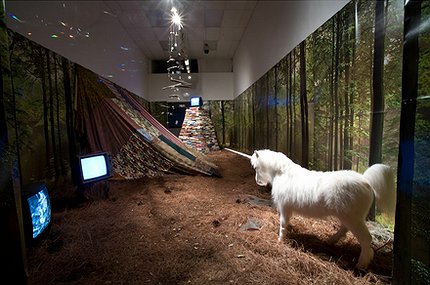In Hebron’s taxonomy, the unicorn has become symbolic of an imagined past. In Final Fantasy she presents a thinly veiled simulation of a forest using photomurals, tree stumps, pine needles and dimmed lights. Wandering through this forest, the viewer encounters (dis)enchanted manifestations of Hebron’s nostalgia and desires: a taxidermied unicorn, a patchwork tent, several old televisions, a ziggurat of books, and a twig and crystal mobile that gently casts tiny rainbows upon the whole scene. Atop the tree stumps, the tower of books, and on the ceiling of the tent are videos that chart loosely narrative reflections about Hebron’s past.
The installation recreates the northern California forest that Hebron lived in as a hippie child in the 70s. The combination of the natural (pine needles, stumps) and simulated (photomurals) materials used to create the forest parallels the disconcerting metamorphosis of the nature-based 70s into the neon-laden 80s. Now in her mid 30’s, Hebron is coming of age with the rest of the Gen-Xers and is questioning the historically touted utopianism of the era of her youth. This show provides a stylized analogy for the act of looking back - and coming to a point of disillusionment - in which the alluring seduction of nostalgia and memory are unpacked far enough to realize that perhaps those days of yore weren’t as utopian as history would have us believe.
Featured in the show is The End of Myth, a small taxidermied unicorn who stands, with its head bowed, the long, phallic, spiraling horn pointed forward in an eternally defensive position. After courting, riding, and seducing the unicorn on previous pieces, here Hebron as finally captured and killed the evasive animal. When I was little, we didn’t have a TV is an 8-foot tall pyramid of nearly 1000 books, with an old television perched on top and displaying still shot of the pacific ocean that mirrors a whale-watcher’s perspective. The act of calmly watching and waiting for a glimpse of an evasive, beautiful animal is not unlike Hebron’s enacted hunt for the unicorn. Look out for the skunks, is a patchwork lean-to, made to recreate the tent that Hebron and her family lived in. The videos projected upon the ceiling present another patchwork, with scenes of heroic landscapes, hedonistic indulgences in the “sex-drugs-and-rock-and-roll” mentality of the day, and illustrated narratives about what happened during the dystopic moments when the free-love attitude went a little too far.
